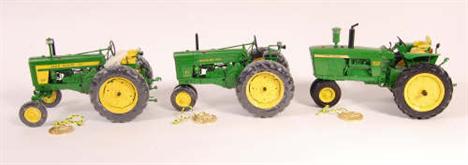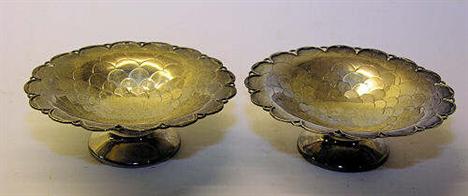We found 216134 price guide item(s) matching your search
There are 216134 lots that match your search criteria. Subscribe now to get instant access to the full price guide service.
Click here to subscribe- List
- Grid
-
216134 item(s)/page
Mid C19th Victorian Oak Barometer the cistern covered with grotesque carved mask, central tube fitted with Mercury Thermometer The Hydrometer? with Ivory scale signed Brown & Son Newcastle with adjustable setting gage, the top carved with acorns & leaves on large C-scroll approx. 38"H x 5 1/4"W
Tri-ang 00 Gauge Electric Scale Model Railway inc. boxed items: RO Passenger Train Princess Elizabeth, R520-6-0 Electric Loco, R16 break van, R17 Bolster Wagon, 511 closed goods van, R18 cable drum wagon, R10 open 121 goods truck, 4x 5101 left hand points (1 by Rovex), 3x R102 right hand points (all by Rovex), R102 hand operated point right hand mark 2, R70 level crossing Rovex, R42 speed control unit, Meccano signals, unboxed items: Princess Elizabeth with coal tender, R10/13, Crescent triple signal, various buffers, track etc.
USA - Barker, George Niagara in summer from below, c. 1888, mammoth plate combination print, approx 50 by 42cm, some fading, framed and glazed Note: Barker settled in Niagara, New York, in 1862, and his images of Niagara soon became his spectacular trademark. They were composed for dramatic effect: a darkened sky, the contrast of churning white water with dark rocks, and an emphasis on tremendous scale. When appropriate, he retouched or added details with pen or pencil, such as the rock in the foreground of Niagara in Summer, from below.
An Early XX Century Scale Model of a Humber Long-Boom Cutter, with a black hull numbered HU334, single mast and flying the ensign, at anchor with trawl net hoisted for drying, 36 cms wide, 52 cms high, displayed in a mahogany 4-glass case with painted ocean backdrop, 65 x 75 x 33 cms overall. * The Cutter was first built in 1859, 56 tons, 50ft in length and 45ft trawl beam.
A well engineered 3-inch scale model of a burrell single cylinder two speed, three shaft traction engine, the welded-steel boiler with fittings including pressure and water gauges, blower, injector, blowdown and two clack valves, ash pan fitted with adjustable door, the single cylinder approximately 1. 3/4 bore x 3in. stroke, fitted with safety valve, Pickering-type governor and mechanical lubricator (lid missing) and Stephenson's link gear, other fittings include eccentric driven feed pump with bypass, adjustable chain steering, disengaging rear wheels with rear axle winch drum with roller wire guides and hand brake on second shaft, finished in green and red, lined in black and white with boiler certificate dated 1989; includes well constructed rubber-tyred four-wheel driver and passenger trailer and a box of accessories, engine 1170mm by 760mm, trailer 1140mm by 610mm
A RARE PARTISAN, LATE 17TH CENTURY, PROBABLY GERMAN with tapering central blade formed with a pronounced medial ridge, a pair of flat up-turned crescentic basal lugs and retaining traces of etching including a figure in contemporary dress on each side, tapering faceted socket and a pair of straps, on an early wooden haft finely carved with scale pattern within a trellis framework of foliage, and with conventional foliage top and bottom (minor chips) 88.5cm; 34 7/8in head Partisans with carved hafts are notably rare.
A COMPOSITE DUTCH PIKEMAN'S ARMOUR, CIRCA 1630 comprising pot with hemispherical crown (slightly dented at either side) formed in two pieces joined medially along a low comb and fitted at the nape with plume-holder retaining significant traces of gilding, integral brim turned down at each side and obtusely pointed front and rear, one-piece breastplate of vestigial 'peascod' form fitted at each side of the chest with a small stud (replaced) for the attachment of a shoulder-strap, struck at the neck with the crowned IR government ownership mark of the time of James II , and flanged outwards at its lower edge to form an integral fauld bearing at either side a pair of pierced studs (replaced) to receive the hinges of a pair of pendant tassets, the hinges fitted at their upper ends with swivel-hooks and tapering at their lower ends to trefoil terminals, the one-piece tassets of trapezoidal form each embossed to simulate six lames, and one-piece backplate flanged outwards at its lower edge and fitted with scaled shoulder-straps and waist-belt (the terminal scale of each of the former and the whole of the latter replaced), its neck-opening struck with the same mark as that of the breastplate, the main edges of the armour decorated with plain inward turns accompanied by incised lines, except on the tassets where they are accompanied by recessed borders, the backplate additionally decorated with a medial incised line, the tassets with vertical columns rivets and pairs of incised lines (much rubbed) at the upper borders of their simulated lames, the surfaces of the armour retaining much of their black finish (extensively pitted, russeted and refreshed), stand not included The armour can be compared with one in the Royal Armouries Museum, Leeds, Inv. No. II. 165 (Blackmore 1990, fig. 77). Armours of this kind are featured in the works of the contemporary military writers J. Bingham, 1616, and Henry Hexam, 1642 (ibid. figs 75 & 95). For the latter see lot 147.
A COMPOSITE HARQUEBUSIER'S ARMOUR, CIRCA 1630-40, LONDON OR GREENWICH, comprising pot with hemispherical skull formed in two pieces joined medially along a low comb, its brow fitted with a broad obtusely-pointed pivoted peak supporting on its underside a triple-barred face-guard riveted through later washers, and its nape, with a matching one-piece neck-guard embossed to simulate four lames (articulation-points and left border showing some damage), one-piece breastplate of late peascod form flanged outwards at its lower edge and fitted at either side of the chest with a pierced stud and swivel- hook for the attachment of a shoulder-strap, the swivel-hook riveted over a fretted rosette washer, and matching one-piece backplate with flanged neck-opening and lower edge, the latter fitted at either side with a pair of later pierced studs, the remainder fitted with incomplete scaled shoulder-straps (only the first scale of each original), a pair of rivets for the attachment of inner shoulder-straps, and a waist-belt (replaced, its buckle detached), and long gauntlet for the left hand formed of a medially-ridged two-piece tubular cuff shaped to the point of the elbow and fitted at its lower end with both an inner and an outer wrist-plate, the former projecting as a semi-circular lobe over the base of the thumb, and the latter bearing three metacarpal-plates, the last having a shaped projection at its inner end for the attachment of a missing thumb-defence and a shaped knuckle-plate, the main edges of the armour decorated with plain inward turns, accompanied on the peak and neck-guard of the pot by recessed borders and elsewhere by single incised lines repeated at all subsidiary edges, its surfaces originally blackened (now extensively rusted), stand not included. This armour is of notable high quality. The absence of London marks makes it likely that it was made in the royal armour workshops at Greenwich. Following an official investigation of criticisms brought against it in 1630, the workshop lost its privilege of working only for the King and those who bore his personal warrant. Its output thereafter is thought to have included pikemens' and harquebusiers' armours of a quality appropriate for wear by officers and select units. Our cuirass resembles one from Littlecote House, Wiltshire, now in the Royal Armouries Museum, Leeds, Inv. No. III. 1957-8, which is thought to have belonged to Col. Alexander Popham, as well as others on loan to that museum from Scrivelsby Court, Lincolnshire, seat of the Dymoke family, hereditary royal champions. Comparison can also be made with the cuirass of the fine Greenwich harquebusier's armour in the Royal Armouries at the Tower of London, Inv. No. II. 92, made for the King Charles II about 1635 (T. Richardson 2004, pp. 11-12). The basal thumb-defence of the gauntlet forming part of the present lot shows the influence of earlier Greenwich examples. The heavy cuirass of the armour is for a man of notable size.
A Derby figure of Britannia, circa 1770, modelled standing wearing a plumed helmet, gilt fish scale bodice and enamelled dress, before a bocage trunk, a shield and lion to her side and martial trophies to her feet, raised on a scroll moulded base picked out in gilt, incised 'No 239 / 3', 25cm high
A VICTORIAN ROSEWOOD BANJO BAROMETER the onion top inlaid with mother of pearl and abalone depicting a spray of flowers above a mercury thermometer with silvered scale, the circular dial with register reading from 28 to 31 inches with ivory button on shaped base, parts of moulding lacking. Height 95cms
A pair of Coalport twin-handled vases and covers, painted with colourful birds to one side, flowers and fruit to the other, within raised gilt floral panels on a blue-scale ground, printed factory marks and pattern numbers in gilt. Restoration to both. Late 19th/early 20th century, 39.5cm. (4)
Live Steam, 5" Gauge Locomotive of LMS 'Crab' number 2700 complete with Tender and original LMS Plans/ Scale-down drawings and notes etc. A wonderful model that did have a boiler test certificate many years ago but will require a new one and some minor attention to see it running again. Built from scratch by an ex Horwich Works Mechanical Engineer.
Australia, 19th Cent. AE tokens, pennies, unless stated: De Carle, Melbourne, 1855, Fleming, Hobart, 1874, Friedman, Hobart, 1857, Hide and De Carle, 1858 and halfpennies, 1857 (2), Hodgson, Melbourne, 1862, Iredale, Sydney, rev. standing justice, undated, Jones, Ipswich (Queensland), undated, Josephs, New Town (Tasmania), 1855 and halfpenny, 1855, MacGregor, Sydney, halfpenny, 1855, Parker, Geelong, undated, Petty, Melbourne, 'V' above scale bar, undated, Sawyer, Brisbane, 1864, Stokes, Melbourne, 1862 (KM/Tn236.1), different varieties (2), Taylor, Melbourne, halfpenny, 1851 (KM/Tn244), Thomas, Melbourne, halfpenny, undated, Thrale & Cross, Melbourne, halfpenny (KM/Tn255), very fine and very scarce, Toogood, Sydney, 1855, Holloway, London, 1858 and halfpenny, 1857, Peace and Plenty, Sydney, 1858 and others (2), latter damaged and some others with staining, otherwise mainly fine or better (26)
-
216134 item(s)/page















































